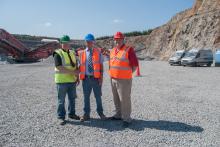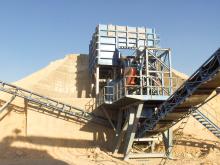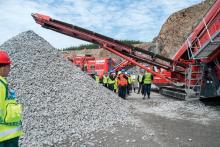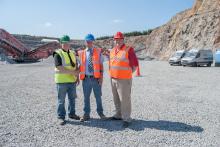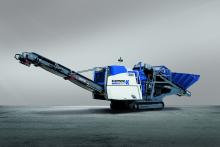
A Scottish quarry near Aberdeen was recently the site of one of the most intense crushing and screening operations ever seen, writes Patrick Smith.
“It is not easy to get 13 machines in one place at one time and get them all working, including eight in a line,” says Nigel Irvine,
This was achieved at the company’s customer days, which were held at the quarry to show much of the company’s equipment at work, including the new Terex Finlay 684, two-deck tracked mobile inclined screen; the recently announced 863 Spaleck recycling unit (ABE, May/June 2013) and the prototype 893 screen.
Other companies have also been highlighting new and updated equipment in the sector, which is being boosted by a large demand from various parts of the world.
For example, in Europe,
“Building a solid work relationship from feasibility to design has been key to the process, bringing savings in time, efficiency and total cost of ownership to our customer,” says François Wintergerst, business manager, MPS Crusher Systems, Mining and Construction, Metso (see News story).
“Because our customers are aiming for more accurate and consistent material separation with lower operational cost, we have taken the acclaimed Metso modular MV vibrator and integrated it into a new screen design,” says Mats Dahlberg, global business manager of vibrating equipment, Mining and Construction, Metso.
The new ES elliptical motion horizontal screen is said to deliver up to 25% more screening capacity compared to a conventional screen of the same size.
Available in selected markets from the end of May, it is said to fit well with other well-known Metso crushers, feeders and screens.
The two unbalanced shaft lines in the Metso ES rotate in opposite directions, generating a high-energy elliptical motion with a self-synchronisation design.
“Letting your screens stand down for maintenance too frequently and for too long makes it hard to reach maximum profitability. That is why the Metso ES features a robust deck frame design, with no welding along the cross member sections to achieve lasting performance.”
The feedbox, discharge spout and cardan shafts of the screen feature Trellex modular wear and impact resistance rubber linings as standard protection.
Trellex products, such as replaceable modular cross beam protection and Trellex LS modular screening media, are optimised for Metso screens, so “are easily available as upgrade options for the Metso ES.”
Efficiency and cost of ownership along with aftersales service are among the main customer demands for crushing and screening equipment, and with the 684, Terex Finlay says the machine, engineered and built for working in quarrying, mining, construction and demolition debris, topsoil, recycling, sand, gravel, coal and aggregate applications, is compact and easily transportable offering operators rapid set-up and tear down times.
The 684’s new screen box features two 4.3m x 1.7m inclined decks providing “efficient screening and high capacity,” says Terex Finlay.
All three discharge conveyors hydraulically fold for transport, and a 1,050mm variable speed belt feeder with hydraulic gearbox drive is fitted to the machine as standard, as is the 8m³ capacity hopper.
Among other innovative equipment is the company’s new 694+ Optidrive, the latest variant inclined screen that is said to offer operators the flexibility to use the onboard diesel/hydraulic power plant or electrical motors connected to mains electricity or an on-site generator to power the 6.1m x 1.52m triple-deck inclined screen.
It was launched at the open event, where the prototype 893 heavy duty screen with a forward-facing inclined modular configuration screen box of 6.1m x 1.8m top deck and a 5.5m x 1.8m bottom deck was seen. This will be launched in the first quarter of 2014.
Meanwhile, launched in the last quarter of 2013 will be the new Terex Finlay C-1540 cone crusher with the new onboard side conveyor configuration that affords operators the opportunity to remove pre-screened fine material from the plant (the C-1540 base model is currently available) and the new Terex Finlay I-100RS direct drive 860mm x 860mm horizontal impact crusher.
The cone crusher features the proven Terex 1000 cone crusher while the I-100RS direct drive, based on the Terex Finlay I-100, features a 2.44m x 1.2m single-deck screen for sizing and recirculating oversize material back to the crushing chamber.
And Terex Finlay has built the J-1170 mobile jaw crusher around its proven 1100mmx700mm units. The jaw crusher, intended for primary reduction and product sizing of blasted rock and ore material, is powered by a choice of a Tier 3/Stage IIIA
Equipped with a 9.6m³ hopper, with self-locking mechanism to speed set-up and teardown, the machine has a transport weight of 45tonnes.
Terex Finlay has also launched the I-100 direct-drive horizontal impact crusher with variable speeds for both quarrying and recycling applications. It is equipped with an electronic control system that monitors and controls the speed of the rotor and regulates the heavy-duty vibrating feeder with integrated pre-screen, to maintain a consistent feed of material. Standard hopper capacity is 2.3m³ and the company claims that the I-100 requires minimal set-up time. Radio remote control is available as an option.
Similar to the mobile impact crushers in the Mobirex EVO series, drive variants with direct drive crushers and electric drives for the vibrating conveyors, belts and the pre-screen, are now used for the crushers, allowing efficient operation and optimal loading.
“The continuous feed system (CFS) controls an even more equal loading of the crushing area, in which the conveying frequencies of the feeder trough and the pre-screen are adapted independently of each other to the level of the crusher and, thus, help increase the performance significantly,” says Kleemann.
New lines
The QI441 features Sandvik’s patented PriSec crushing chamber, which is designed for rapid switching between primary and secondary crushing applications, and two hydraulically adjusted curtains permit the production of a wide range of product sizes.
Increased discharge heights and conveyor lengths are said to deliver up to 50% more stockpiling capacity and the machine’s heavy-duty apron feeder allows the crusher to handle large in-feed. The machine has a
20% increase in hopper capacity and an aggressive screen box design to ensure maximum productivity.
A development of the company’s Hydrocone design, the CH550 cone crusher can be configured for either secondary or tertiary crushing applications with a wide performance range. The company’s ASRi automatic setting system is included as standard, and is said to deliver optimum material reduction and end product shape, ensuring that the machine is used within its design capacity.
“The CH550 produces up to 30tonnes less CO2 emissions per year, as well as reducing operating costs, and it has a rated power of 330kW and a head diameter of up to 1,100mm. By using just three eccentric bushings customers can cover up to 90% of material output sizes,” says Sandvik.
Meanwhile, specialist crushing and screening contractor Crush, based in south Wales, and a customer of
“We tested the machine on a variety of applications including recycled asphalt, limestone and grit stone. The impressive performance of the XH320X test machine along with our direct input on design from a customer perspective allowed us to be involved in the final design which took on board the varying applications that a contractor has to work,” says Ben Sherratt, operations director with Crush.
The XH320X is said to feature rapid set-up time, fuel efficient direct drive system and output potential of up to 320tonnes/hour, being developed to incorporate a fully independent hydraulically driven pre-screen, thus improving fines removal and reducing chamber wear costs.
Powerscreen’s XA400S pre-screen jaw crusher features a hydraulically driven pre-screen with increased drop angle on the bottom deck improving machine throughput and capacity while the discharge opening from the under chute has been increased from 200mm to 320mm, allowing faster movement of pre-screened material to bypass the crushing chamber.
With its French partner, Mint Equipment, dsb Innocrush has clinched an order for the supply of another Innocrush 35 impact crusher. With capacities of up to 350tonnes/hour both have been delivered to the customer, Mahé, based in Nozay, France, where it employs 50 people and maintains a large fleet of around 60 machines, including earthmoving equipment, excavators, and trucks as well as crushers and screens.
As Mahé landed more contracts for crushing different materials for recycling, the need arose for another mobile crusher, says Dominique Mahé, the company’s managing director.
With a length of 11.6m, a width of 2.55m, a height of 3.22m and an operating weight of 35.5tonnes, the Innocrush 35, driven by a Cat-C11 diesel engine producing 287kW, has been designed as a very compact machine, says the company.
Also compact is the new
The 29tonne John Deere-powered machine has a 3m loading height, an asymmetric vibro feeder and a pre-screen measuring 1,500x900mm. It is fitted with a 1m wide main discharge belt and has a stockpiling height of 3.3m. Screened discharge is via a 500mm-wide belt with a 2.4m discharge height.
Developed by
The crusher is equipped with the Telsmith Trac10 series automated control system, which provides automated calibration and setting control, protecting the crusher from overload and enhancing performance and efficiency.
The Trac10 system continuously monitors operations with sensors checking crusher lube, hydraulic and electrical systems, making adjustments and providing early advanced warning alarms when required.
Another development has come about due to increasing demand to turn waste into useable products and reduce overall costs, which has seen a growth in demand, often for smaller crushers, where the initial capital outlay is lower than a traditional crusher.
As a result of this, Winfield Engineering and
Work has started on the £1m (€1.2 million) investment which, when completed (scheduled for September 2013), will provide a 50% increase in production capacity; improved production efficiencies; new offices and a dedicated training, testing and installation facility for the new crushers being built.
The expansion has been necessary to meet the increasing focus on waste transfer stations, municipalities and construction companies to reduce their own costs to landfill.
“The growing demand for the recently developed 7000 Plus to the existing range means that medium-scale crushing on site can be achieved in a very affordable way. Sales of the 7000 Plus with the grizzly vibrating table have revolutionised the way construction and demolition sites handle waste on-site,” says Jason Purliant, sales and marketing director at Red Rhino, which is looking to appoint new dealers in key areas around the world, including the emerging Brazilian markets and North America.
“Every country is experiencing the same challenges to reduce waste to landfill.”
Screen debuts
“Germany is a very important market for Anaconda and we were delighted to be represented by Prall-Tec at the recent NordBau show in Germany,” says Micheal Burns, European dealer manager.
Among highlights was the company’s entry level DF410 tracked screener, which screens and stockpiles up to 250tonnes/hour of material into three sizes.
W.S. Tyler, a wholly-owned subsidiary of the German-based Haver & Tyler, is now offering its consultative Pro-Deck approach to vibrating screens using modular screen media, allowing customers the flexibility of modular panels.
The Pro-Deck package includes an audit of the entire machine, using sensors installed in the equipment to analyse the performance of components such as bearings.
Factors such as the type of screen media can be assessed and then changed if necessary, so as to optimise the whole equipment package.
The company says that using Pro-Deck allows different style screen panels to be used so as to optimise both wear life and open area. The process uses the company’s vibration analysis techniques and allows the use of multiple types of screen media on a single deck, instead of using the same screen media.
It carried out extensive research and years of experience showed that “more than one type of screen media extends the life of the screen media while also increasing efficiency.”
Additionally, the Pro-Deck approach is said to help eliminate common screening problems such as blinding, pegging and premature wear that cause unscheduled downtime.
“What makes Flex Mat different is that it’s not woven and we use polyurethane strips to hold it together. Because of this it will flex, which eliminates pegging and clogging as the crosswires vibrate,” says Major Wire.
Impact from large aggregate material can cause screen breakage with even the heaviest single wire gauges, says Major Wire, which manufactures Double Weave from abrasion-resistant OptimumWire, a high carbon and high manganese content material.
It is also available in stainless steel, which helps reduce blinding in sticky material applications, and producers can choose opening sizes from 31.8-127mm and wire diameters from 6.2-12.7mm.

